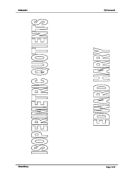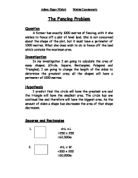Results
I have found that IQs of the triangles I looked are not directly linked to their area, but to their shape. I also found that the shape with the smallest difference between the lengths of the sides had the largest IQ while the shape with the largest difference between the lengths of the sides had the smallest IQ.
Isosceles Triangles
I will now do what I did for right-angled triangles for isosceles triangles; I will also look for similarities and differences between the two types of triangle.
Pair One
The two triangles had the same perimeter but different areas; this shows that the IQ of a shape is not directly related to its perimeter. Similar results were seen with the first pair of right-angled triangles. As with the previous second pair I will now compare similar shaped triangles.
Pair Two
As with the second pair of right-angled triangles, the similar shaped triangles had the same IQs.
Results
With both sets of triangles we can see that triangles that have identical perimeters or areas have different IQs, therefor the IQ of a shape is not linked to its area or perimeter. We also see that similar shapes have identical IQs. We also see that with a smaller difference between the length of the sides, the greater the IQ.
Equilateral Triangles
I will now look at equilateral triangles, from the last two sets of triangles we can see that similar shapes produce identical IQs. Since all equilateral triangles are similar I predict that all equilateral triangles will have the same IQ.
I will study three triangles to see if my theory is correct.
Results
All of the IQs were the same, as I predicted. This is because all equilateral triangles are similar and IQs for similar shapes are identical.
Four Sided Shapes
I will now look at four sided shapes; I will look at squares, rectangles and irregular four sided shapes.
Squares
Since all squares are similar, like equilateral triangles, I expect all squares to have identical IQs.
I will look at three squares to prove this.
Results
As I predicted all the squares had identical IQs, also the square IQ was larger than the equilateral triangle IQ.
Rectangles
I expect that the rectangles with the smallest difference between the sides will have the largest IQs while the rectangles with the largest difference will have the smallest IQs.
I will do three rectangles to prove this.
Results
As I predicted, the smaller the difference in the sides, the larger the IQ.
Irregular Four Sided Shapes
I will look now at irregular four sided shapes and compare them to regular shapes.
Results
Like with the regular polygons, the shapes that are similar have identical IQs.
Five-Sided-Shapes
I will now look at five-sided shapes; I will look at regular pentagons and irregular pentagons. I will try to find similarities with the other shapes.
Pentagons
I will now look at regular pentagons, since all regular pentagons are similar I expect all the IQs to be the same.
Results
As I predicted, all the pentagons had identical IQs. There was also the formula
∏ / 5 tan 36
reoccurring in each equation, I will look into this in the next set of shapes. Also, the IQs were larger that the square IQs. This increase has also been seen from triangles to squares. This is probably a pattern.
Irregular Pentagons
I will now look at irregular pentagons. I will do one with all sides equal, like a regular pentagon, and one without. I will see if
∏ / 5 tan 36
occurs in one of them, I expect it to, if it occurs, to occur in the one with equal sides as it is like a regular pentagon.
Results
The
∏ / 5 tan 36
did not occur. Also the shape with the equal sides had the smallest IQ. These results at first glance may seem contradictory to my previous results. I will have to look into this.
Six-Sided Shapes
I will now look at six sided shapes; I will look at regular hexagons and irregular hexagons.
Hexagons
I will look at hexagons; I expect all the hexagons to have the same IQ like all the other regular shapes, I will also see if a formula similar to the pentagon
∏ / 5tan 36
appears.
Results
All the hexagons had the same IQ as I predicted; again we see an increase in IQ from the previous shapes. Also
∏ / 6 tan 30
appears, which is similar to
∏ / 5 tan 36
for pentagons. I will look into this after I do the irregular hexagons.
Irregular Hexagons
I will now look at irregular hexagons, I will see if the results shown here are similar to the ones shown in irregular pentagons.
Results
The results were consistent with the irregular pentagons, which is that with a smaller difference between the sides of the regular shape and the total of the other sides, a larger IQ.
General Formula
By looking at my past results, I think that a simpler formula for finding the IQ of any regular shape, where n is the number of sides, is
∏ / n tan (180/n)
I will check this formula on a regular heptagon and octagon.
Heptagon
I will now test my general formula on a Heptagon.
This shape works out with my formula, as
∏ / 7 tan (360/14) or ∏ / 7 tan (180/7)
is correct for
∏ / n tan (180/n)
Also we see an increase in IQ.
Octagon
The octagon also corresponds with the formula. Again an increase in IQ.
All regular shapes
The formula works for a heptagon and an octagon. I will now check if it works out for all regular shapes
As you can see, the formula works for all regular shapes. We have seen that with an increasing number of sides of regular shapes, a larger IQ is given. The increase is exponentially decreasing e.g. triangle = 0.604599788
Square = 0.785398163
Increase of 0.180798975
Pentagon = 0.864806266
Increase of 0.079408103
Any series of numbers that display exponential properties can in theory continue indefinitely, but this series has a limit, being the number of sides. The shape with the largest number of sides is a circle, with an infinite number of sides. So far we have seen that all IQs are between 0 and 1. With a circle being the limit to the series, I expect the circle to have an IQ of 1.
Circle
I will now investigate the circle, as I said I expect it to have an IQ of 1. I will also test my general regular formula on it.
My prediction was correct; I will now test my regular shape formula.
The circle works for my regular shape formula.
Final Conclusion
After reading through all my results and findings. I believe that the IQ of a shape is a measure of how compact/spherical it is. I think this because, with a smaller difference in sides, a larger IQ. Regular shapes have lager IQs than irregular shapes with the same number of sides. An increase in IQ is seen with larger numbers of sides and finally, a circle, the most compact/spherical shape possible, has the largest IQ possible.







